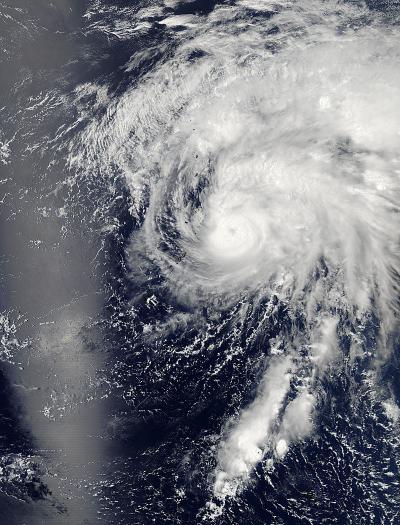Tapah downgrades to a depression

Aqua captured this image of the tropical depression Tapah on April 29, 2014, at 11:55 p.m. EDT (3:55 UTC) in the western Pacific Ocean. Credit: NASA Goddard's MODIS Rapid Response Team
Tapah rapidly dissipated due to the effected of strong vertical windshear from the west and a sharp decreased in sea surface temperature.
The storm is currently tracking northwest at 10 knots per hour and is expected to recurve to the northeast and accelerate.
Maximum wave height is currently 10 feet. The storm will be monitored for signs of regeneration.
NASA captured this image of the storm with the Moderate Resolution Imaging Spectroradiometer or MODIS instrument aboard NASA's Aqua satellite on April 29, 2014 at 11:55 p.m. EDT (3:55 UTC) in the western Pacific Ocean.
Media Contact
More Information:
http://www.nasa.govAll latest news from the category: Earth Sciences
Earth Sciences (also referred to as Geosciences), which deals with basic issues surrounding our planet, plays a vital role in the area of energy and raw materials supply.
Earth Sciences comprises subjects such as geology, geography, geological informatics, paleontology, mineralogy, petrography, crystallography, geophysics, geodesy, glaciology, cartography, photogrammetry, meteorology and seismology, early-warning systems, earthquake research and polar research.
Newest articles

High-energy-density aqueous battery based on halogen multi-electron transfer
Traditional non-aqueous lithium-ion batteries have a high energy density, but their safety is compromised due to the flammable organic electrolytes they utilize. Aqueous batteries use water as the solvent for…

First-ever combined heart pump and pig kidney transplant
…gives new hope to patient with terminal illness. Surgeons at NYU Langone Health performed the first-ever combined mechanical heart pump and gene-edited pig kidney transplant surgery in a 54-year-old woman…

Biophysics: Testing how well biomarkers work
LMU researchers have developed a method to determine how reliably target proteins can be labeled using super-resolution fluorescence microscopy. Modern microscopy techniques make it possible to examine the inner workings…





















